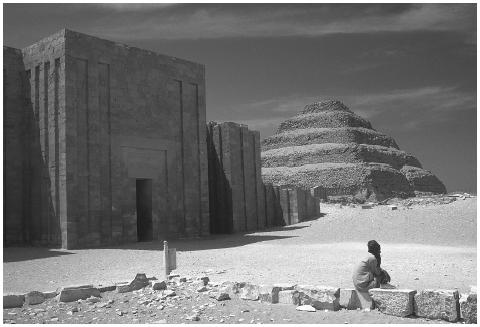Pyramids
Historians have said that most of what humans know about ancient cultures is based on funerary artifacts. Certainly no other example of mortuary culture stands out in modern consciousness than the Egyptian pyramids. The first large-scale stone construction in Egypt was the funerary complex of the Third Dynasty king, Netjerikhet Djoser at Saqqara, demonstrating already at this point in history the strong connection between the pyramid and the royal afterlife. This monument was designed by the king's famous vizier and overseer of

These enormous constructions must have placed a considerable strain on the nation's resources, so it is not surprising that after the Fourth Dynasty both pyramids and royal mortuary complexes and their pyramids dramatically decreased in scale and their construction was shoddier. After some rather small monuments at the beginning of the Eighteenth Dynasty, pyramids ceased to be used for royal burials. Nevertheless, the Egyptians continued to consider pyramids as the most preferable tomb form so that small versions were occasionally incorporated into the superstructure of private tombs during the New Kingdom and Ramesside periods.
The fact that such an inconceivable amount of energy would be expended on these massive funerary structures has given rise to many fantastical alternative explanations as to their origin and purpose. Even though texts explain little specifically about the meaning of the pyramids and say virtually nothing about how they were built, the preponderance of evidence clearly shows that they were intended as the kings' funerary monuments. A combination of archaeological evidence from the sites along with some sparse textual material clearly demonstrates a connection between these monuments and the royal mortuary cult. However, there was a strong association with worship of the sun god Re, the chief religious belief during the Old Kingdom. The pyramids' shape reminds some of a staircase, but a similarity with a sunburst seems a more probable intent.
Normally the pyramid was the largest part of a vast, tripartite temple enclosure whose purpose was to maintain the king's cult, theoretically in perpetuity. The design details changed constantly, but retained essentially the same pattern. The main access to the pyramid complex was at the valley temple at the edge of the cultivation in the Nile valley, usually affording access to a canal. The valley temple was connected to the high desert plateau by a covered causeway. Finally, the pyramid precinct itself was surrounded by an enclosure wall behind which were subsidiary temples and satellite pyramids intended for the king's soul or family members.
The very fact that the pyramids were intended for the king meant that they had a much broader connection with religion. In Egyptian religious and political ideology, the king—who was both the earthly incarnation of the god Horus and the son of the sun god Ra—was always the nexus between humanity and the realm of the gods. Therefore the pyramids were not merely royal tombs but national endeavors that could help all Egyptians in terms of the gods and the afterlife, reminiscent of the spirit that one can sense behind the great European cathedrals. Interestingly, they did provide at least symbolic immortality to their occupants.
See also: Egyptian Book of the Dead ; Immortality ; Mummification ; Tombs
Bibliography
Edwards, I. E. S. The Pyramids of Egypt. Harmondsworth: 1985.
Lehner, Mark. The Complete Pyramids. New York: Thames and Hudson, 1997.
OGDEN GOELET JR.
Comment about this article, ask questions, or add new information about this topic: